Puducherry, formerly known as Pondicherry, is a unique Union Territory of India that boasts a rich cultural heritage shaped by Tamil traditions, French colonial influence, and local folk art. The dance forms of Puducherry reflect this blend, offering a captivating mix of classical, folk, and ritualistic performances.
Despite its small size, Puducherry has a vibrant artistic community that has preserved and promoted its traditional dance forms through temple festivals, village fairs, and special cultural events. From Bharatanatyam to the lively Garadi dance, the region showcases a wide variety of performances that highlight its deep-rooted traditions.
Here’s a look at some of the most prominent traditional dance forms of Puducherry:
1. Bharatanatyam – The Classical Dance of Puducherry
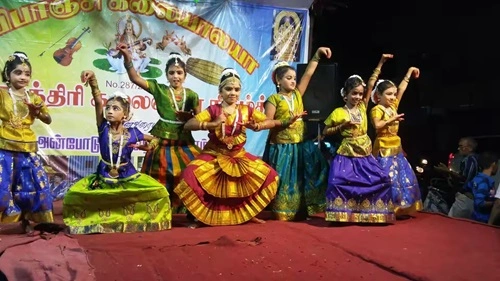
Bharatanatyam, one of the oldest and most revered classical dance forms of India, is widely practiced in Puducherry. The dance originated in Tamil Nadu but has found a strong presence in Puducherry due to its Tamil cultural influence.
Significance:
- Bharatanatyam is a temple dance form that narrates stories from Hindu mythology through expressive hand gestures (mudras) and facial expressions (bhavas).
- It is performed in temples, cultural festivals, and special occasions like Pongal and Navaratri.
- Puducherry has several Bharatanatyam schools where students are trained in this traditional art form.
2. Garadi Dance – The Folk Dance of Puducherry
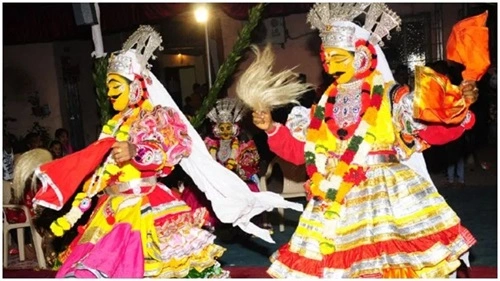
Garadi is one of the most popular folk dances of Puducherry, believed to have been performed by the Vanara Sena (monkey army) in the Ramayana after Lord Rama’s victory over Ravana. The dance is characterized by its energetic movements, colorful costumes, and rhythmic beats.
Significance:
- It is performed during major festivals and social gatherings, including Pongal, Diwali, and temple processions.
- Dancers wear traditional attire resembling monkey warriors, often carrying wooden sticks and shields.
- The music is provided by folk instruments like thavil (drum) and nadaswaram (wind instrument), creating a festive atmosphere.
3. Kummi Dance – The Harvest Dance of Puducherry
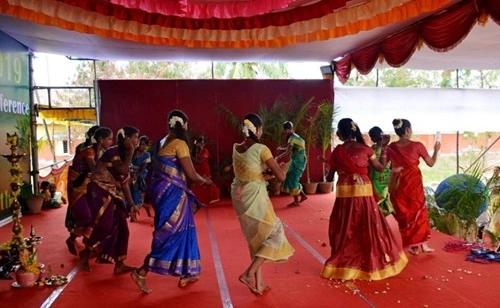
Kummi is a simple yet rhythmic folk dance performed by women, particularly during harvest festivals like Pongal. The dance involves clapping and circular movements while singing traditional folk songs.
Significance:
- It is performed by village women to express gratitude to nature for a good harvest.
- The dance is often seen in rural areas of Puducherry, keeping Tamil folk traditions alive.
- The movements are simple yet graceful, making it a participatory dance where the entire community can join.
4. Kolattam – The Stick Dance of Puducherry
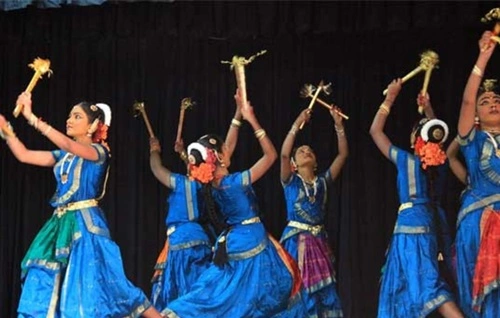
Kolattam, also known as “stick dance,” is a vibrant folk dance performed by women and young girls. It is similar to Dandiya Raas of Gujarat but has a distinct Tamil cultural influence.
Significance:
- It is performed during Navaratri, village fairs, and temple festivals.
- Dancers hold two wooden sticks (kolattam) and strike them rhythmically while moving in circles.
- It represents harmony, coordination, and joy, often performed in groups.
5. Villupattu – The Musical Storytelling Dance
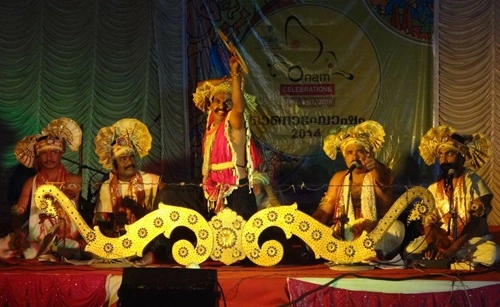
Villupattu, meaning “bow song,” is a unique folk dance and musical storytelling tradition of Puducherry and Tamil Nadu. It combines dance, music, and narration to depict religious and social themes.
Significance:
- It is performed using a large bow-shaped instrument (villu) that acts as a musical instrument and a prop.
- Villupattu is commonly performed in temples, rural fairs, and religious gatherings.
- The themes often include mythological tales, social messages, and folklore.
6. Devaraattam – The Warrior Dance of Puducherry
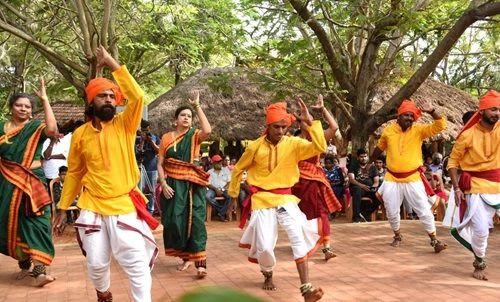
Devaraattam is a traditional dance of the Kshatriya (warrior) community, performed to celebrate victory in battles. It has its roots in Tamil Nadu but is also popular in Puducherry.
Significance:
- The dance is performed without any musical lyrics, relying entirely on energetic movements and instrumental beats.
- It is performed by men dressed in warrior costumes, showcasing their agility and strength.
- Today, it is performed during festivals and cultural events as a tribute to the warrior spirit of Tamil culture.
7. Kavadi Aattam – The Devotional Dance of Murugan Worship
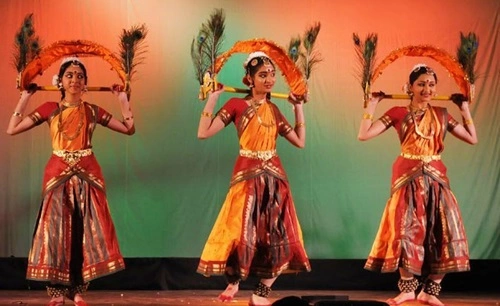
Kavadi Aattam is a devotional dance dedicated to Lord Murugan, often performed during the Thaipusam festival in Puducherry. It involves carrying a Kavadi (decorated wooden structure) on the shoulders while dancing in devotion.
Significance:
- Devotees perform this dance as an offering to Lord Murugan, seeking blessings and fulfillment of their vows.
- The dance is accompanied by drum beats and chants, creating a spiritual ambiance.
- It reflects deep religious faith and endurance, as devotees often perform it barefoot for long distances.
8. Karagattam – The Pot Dance of Tamil Culture
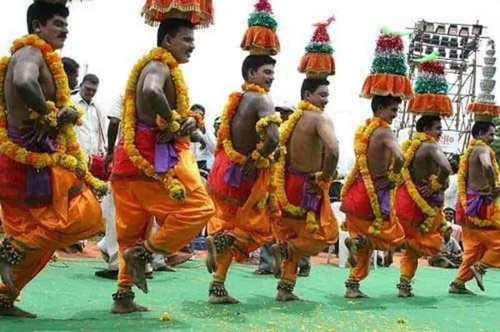
Karagattam is a Tamil folk dance performed by balancing a decorated pot (karagam) on the head while dancing gracefully. It is common in rural Puducherry during temple festivals.
Significance:
- The dance is dedicated to goddesses Mariamman and Amman, who are worshipped for rain and prosperity.
- Dancers perform intricate balancing movements, sometimes adding acrobatics and fire-juggling.
- It is a symbol of devotion, grace, and rural folk tradition.
9. Therukoothu – The Street Theatre Dance
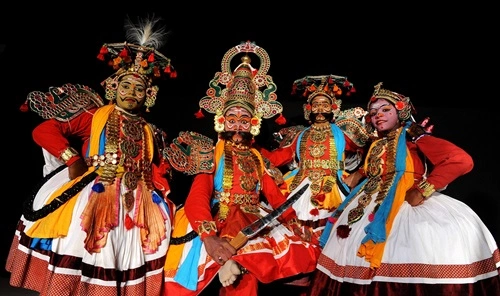
Therukoothu, meaning “street play,” is a folk dance-drama performed in Puducherry and Tamil Nadu. It combines dance, drama, and music to enact mythological stories.
Significance:
- Performed mainly in open-air theaters, temple courtyards, and village fairs.
- Actors wear elaborate costumes and heavy makeup, portraying characters from Ramayana and Mahabharata.
- It serves as entertainment as well as a medium for spreading moral and religious values.
Conclusion
The traditional dances of Puducherry beautifully reflect the region’s Tamil heritage, folk traditions, and devotional practices. From the elegant Bharatanatyam to the energetic Garadi dance, each dance form carries a deep cultural significance. These dances are not only performed for entertainment but also serve as expressions of spirituality, history, and social values.
Despite modernization, efforts are being made to preserve these art forms through government initiatives, cultural festivals, and community programs. Puducherry’s dance traditions remain an integral part of its identity, showcasing the timeless beauty of Indian folk and classical dance.
Whether performed in temples, village squares, or grand cultural festivals, these dances continue to bring people together, celebrating the spirit, devotion, and artistry of Puducherry.

